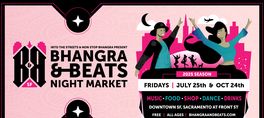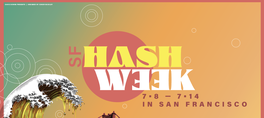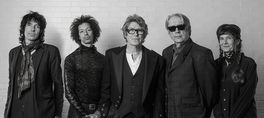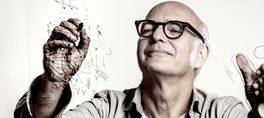For decades Michael Jang flew under the radar, his career as a professional artist first gathering public acclaim in 2001 with the submission of a portfolio of images from the 1970s to the San Francisco Museum of Modern Art. Like Jang's oeuvre, the underground setting of this latest exhibition presented by Lee Gallery shifts our everyday coordinates--what's right under our noses, on the streets and sidewalks? If you haven't been paying attention, this exhibition is your alert to an artist making their literal mark on the city and redefining what their prime looks like.
Post No Jangs: Notes from Underground opens in the basement of Crown Point Press, directly across from SFMOMA, where pristine black and white gelatin silver prints by Jang live in the permanent collection. You won't find any clean photographs or murals hanging on the walls here though. Installed with the help of longtime friends and collaborators, assistant Brent Willson and curator Adrian Martinez, Jang's most recent works demand physical engagement: mounted on plywood, some sit in the hallway floor, others are arrayed like an altar in the main room. Ripped and written over, stickered over, these images leap out at the viewer. Such ad hoc layout directly expresses the mode of working on the street and epitomizes the spontaneity and community that have been core tenets of Jang's career. At his solo exhibition at McEvoy Foundation for the Arts (2019-20), it was the backroom with its graffitied pictures tacked to the wall which first hinted at this series developed during the pandemic. In 2021 Jang was awarded a Guggenheim Fellowship to continue stretching the limits of photography; with the words "Post No Jangs," the artist teasingly proclaims his own blacklist, transforming the stenciled tagline into a new calling card. The art world may be familiar with his more traditional photographs, but what San Francisco knows is that the sharpest street artist out there wheat-pasting and spray-painting is a septuagenarian fluent in pop culture and a visual vocabulary that tackles everything from takeout food to anti-Asian violence.
The underground has always been a good place to generate resistance or germinate revolution, as Dostoevsky's eponymous figure understood. As subversion of the above-ground, it harbors a crucial edge. It harkens of course to Jang's aesthetic roots photographing rock and punk bands and collaborating with skateboarders. It also recalls the Basement Workshop (1970-86), an influential Asian American arts collective started in Manhattan's Chinatown whose members would go on to found the Museum of Chinese in America and political publications like Yellow Pearl. Grassroots, informal, liberating--like Michael Jang's own story.
Come for a street artist's take-over of the traditional gallery space: today's Dadaist collage, the West Coast's Basquiat. Stay for the punch of Jang's underground.
show less
Post No Jangs: Notes from Underground opens in the basement of Crown Point Press, directly across from SFMOMA, where pristine black and white gelatin silver prints by Jang live in the permanent collection. You won't find any clean photographs or murals hanging on the walls here though. Installed with the help of longtime friends and collaborators, assistant Brent Willson and curator Adrian Martinez, Jang's most recent works demand physical engagement: mounted on plywood, some sit in the hallway floor, others are arrayed like an altar in the main room. Ripped and written over, stickered over, these images leap out at the viewer. Such ad hoc layout directly expresses the mode of working on the street and epitomizes the spontaneity and community that have been core tenets of Jang's career. At his solo exhibition at McEvoy Foundation for the Arts (2019-20), it was the backroom with its graffitied pictures tacked to the wall which first hinted at this series developed during the pandemic. In 2021 Jang was awarded a Guggenheim Fellowship to continue stretching the limits of photography; with the words "Post No Jangs," the artist teasingly proclaims his own blacklist, transforming the stenciled tagline into a new calling card. The art world may be familiar with his more traditional photographs, but what San Francisco knows is that the sharpest street artist out there wheat-pasting and spray-painting is a septuagenarian fluent in pop culture and a visual vocabulary that tackles everything from takeout food to anti-Asian violence.
The underground has always been a good place to generate resistance or germinate revolution, as Dostoevsky's eponymous figure understood. As subversion of the above-ground, it harbors a crucial edge. It harkens of course to Jang's aesthetic roots photographing rock and punk bands and collaborating with skateboarders. It also recalls the Basement Workshop (1970-86), an influential Asian American arts collective started in Manhattan's Chinatown whose members would go on to found the Museum of Chinese in America and political publications like Yellow Pearl. Grassroots, informal, liberating--like Michael Jang's own story.
Come for a street artist's take-over of the traditional gallery space: today's Dadaist collage, the West Coast's Basquiat. Stay for the punch of Jang's underground.
For decades Michael Jang flew under the radar, his career as a professional artist first gathering public acclaim in 2001 with the submission of a portfolio of images from the 1970s to the San Francisco Museum of Modern Art. Like Jang's oeuvre, the underground setting of this latest exhibition presented by Lee Gallery shifts our everyday coordinates--what's right under our noses, on the streets and sidewalks? If you haven't been paying attention, this exhibition is your alert to an artist making their literal mark on the city and redefining what their prime looks like.
Post No Jangs: Notes from Underground opens in the basement of Crown Point Press, directly across from SFMOMA, where pristine black and white gelatin silver prints by Jang live in the permanent collection. You won't find any clean photographs or murals hanging on the walls here though. Installed with the help of longtime friends and collaborators, assistant Brent Willson and curator Adrian Martinez, Jang's most recent works demand physical engagement: mounted on plywood, some sit in the hallway floor, others are arrayed like an altar in the main room. Ripped and written over, stickered over, these images leap out at the viewer. Such ad hoc layout directly expresses the mode of working on the street and epitomizes the spontaneity and community that have been core tenets of Jang's career. At his solo exhibition at McEvoy Foundation for the Arts (2019-20), it was the backroom with its graffitied pictures tacked to the wall which first hinted at this series developed during the pandemic. In 2021 Jang was awarded a Guggenheim Fellowship to continue stretching the limits of photography; with the words "Post No Jangs," the artist teasingly proclaims his own blacklist, transforming the stenciled tagline into a new calling card. The art world may be familiar with his more traditional photographs, but what San Francisco knows is that the sharpest street artist out there wheat-pasting and spray-painting is a septuagenarian fluent in pop culture and a visual vocabulary that tackles everything from takeout food to anti-Asian violence.
The underground has always been a good place to generate resistance or germinate revolution, as Dostoevsky's eponymous figure understood. As subversion of the above-ground, it harbors a crucial edge. It harkens of course to Jang's aesthetic roots photographing rock and punk bands and collaborating with skateboarders. It also recalls the Basement Workshop (1970-86), an influential Asian American arts collective started in Manhattan's Chinatown whose members would go on to found the Museum of Chinese in America and political publications like Yellow Pearl. Grassroots, informal, liberating--like Michael Jang's own story.
Come for a street artist's take-over of the traditional gallery space: today's Dadaist collage, the West Coast's Basquiat. Stay for the punch of Jang's underground.
read more
Post No Jangs: Notes from Underground opens in the basement of Crown Point Press, directly across from SFMOMA, where pristine black and white gelatin silver prints by Jang live in the permanent collection. You won't find any clean photographs or murals hanging on the walls here though. Installed with the help of longtime friends and collaborators, assistant Brent Willson and curator Adrian Martinez, Jang's most recent works demand physical engagement: mounted on plywood, some sit in the hallway floor, others are arrayed like an altar in the main room. Ripped and written over, stickered over, these images leap out at the viewer. Such ad hoc layout directly expresses the mode of working on the street and epitomizes the spontaneity and community that have been core tenets of Jang's career. At his solo exhibition at McEvoy Foundation for the Arts (2019-20), it was the backroom with its graffitied pictures tacked to the wall which first hinted at this series developed during the pandemic. In 2021 Jang was awarded a Guggenheim Fellowship to continue stretching the limits of photography; with the words "Post No Jangs," the artist teasingly proclaims his own blacklist, transforming the stenciled tagline into a new calling card. The art world may be familiar with his more traditional photographs, but what San Francisco knows is that the sharpest street artist out there wheat-pasting and spray-painting is a septuagenarian fluent in pop culture and a visual vocabulary that tackles everything from takeout food to anti-Asian violence.
The underground has always been a good place to generate resistance or germinate revolution, as Dostoevsky's eponymous figure understood. As subversion of the above-ground, it harbors a crucial edge. It harkens of course to Jang's aesthetic roots photographing rock and punk bands and collaborating with skateboarders. It also recalls the Basement Workshop (1970-86), an influential Asian American arts collective started in Manhattan's Chinatown whose members would go on to found the Museum of Chinese in America and political publications like Yellow Pearl. Grassroots, informal, liberating--like Michael Jang's own story.
Come for a street artist's take-over of the traditional gallery space: today's Dadaist collage, the West Coast's Basquiat. Stay for the punch of Jang's underground.
show less
Date/Times:
20 Hawthorne Street, San Francisco, CA 94105
The Best Events
Every Week in Your Inbox
From Our Sponsors
UPCOMING EVENTS
Great suggestion! We'll be in touch.
Event reviewed successfully.











